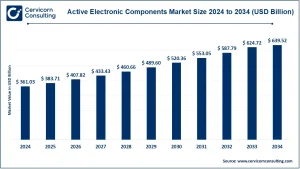Market Overview
The solid state battery market is rapidly emerging as a disruptive force in global energy storage. Offering higher safety, increased energy density, and extended lifespan compared to conventional lithium-ion batteries, solid-state technology represents the next major advancement in battery innovation.
In 2024, the global solid-state battery market was valued at approximately USD 1.24 billion and is projected to surge to around USD 15.67 billion by 2034, expanding at a remarkable CAGR of 57% from 2025 to 2034. This rapid growth reflects increasing demand for high-performance energy storage solutions across electric vehicles (EVs), consumer electronics, and renewable energy applications.
Key Market Trends
1. Hybrid and Composite Electrolytes
Research in solid-state batteries is increasingly focused on hybrid and composite electrolytes, combining materials such as sulfides, oxides, and polymers. This multi-material strategy optimizes ionic conductivity, stability, and manufacturability while overcoming limitations inherent to single-material systems. Enhanced performance and scalability from this approach are driving commercial adoption.
2. Interface Engineering for Stability
The electrode–electrolyte interface remains a critical challenge. Manufacturers are deploying advanced interface engineering techniques, including coatings, interlayers, and gradient materials, to reduce lithium dendrite formation and contact resistance. These innovations improve battery safety, efficiency, and longevity.
3. Scalable Manufacturing & Li-Ion Compatibility
Companies are designing solid-state batteries compatible with existing lithium-ion production infrastructure, enabling cost-efficient scale-up. Leveraging current gigafactory capabilities allows for a smoother transition from prototype to mass production, accelerating market entry.
4. Regulatory Support and Safety Focus
Global regulations on battery safety, recycling, and sustainability are indirectly supporting SSB adoption. Non-flammable electrolytes and superior thermal stability align with stricter safety standards, encouraging industries such as EVs, aerospace, and medical devices to embrace solid-state technologies.
5. Demand for Faster Charging and Extended Range
OEMs and end-users are increasingly prioritizing rapid-charging, high-energy-density batteries. Solid-state technology meets these requirements, enabling faster charging and extended operational times for EVs and portable electronics, guiding industry R&D priorities.
Market Drivers
1. High-Performance EVs and Electronics Demand
The shift toward electric mobility and advanced electronics is the primary market driver. SSBs provide superior energy density, faster charging, and longer life cycles, making them suitable for EVs, drones, and premium electronics. Between 2025 and 2034, the market is expected to grow nearly tenfold.
2. Government Incentives and Policy Support
Governments across North America, Europe, and Asia-Pacific are offering grants, subsidies, and tax incentives for next-generation batteries. These initiatives promote clean energy, reduce fossil fuel dependency, and support early-stage commercialization and production scaling.
3. Technological Innovation
Advancements in solid electrolytes, electrode interfaces, and cell architectures are bridging the gap from laboratory prototypes to commercial feasibility. Improvements in ionic conductivity, thermal stability, and cycle life are turning SSBs into practical, deployable solutions.
4. Strategic Collaborations
Cross-industry partnerships among battery manufacturers, automakers, and material suppliers are accelerating development. Joint ventures and OEM collaborations help optimize supply chains, scale pilot programs, and bring solid-state batteries closer to mass production.
5. Safety and Environmental Benefits
Safety advantages — such as eliminating flammable liquid electrolytes — and longer lifespans reduce fire risk and battery waste. These attributes support eco-friendly energy storage initiatives, making SSBs attractive for various applications.
Impact of Trends and Drivers
Application-Level Impact
-
EVs: SSBs extend driving range and reduce charging times, supporting widespread EV adoption.
-
Consumer Electronics: Miniaturization and enhanced safety make SSBs ideal for wearables, smartphones, and medical devices.
-
Grid & Renewable Storage: Long lifespan and stability suit grid-scale energy storage, ensuring safety and durability.
Regional Impact
-
Asia-Pacific: Dominates production, driven by strong manufacturing in Japan, China, and South Korea.
-
Europe: Focused on R&D and sustainable manufacturing policies.
-
North America: Adoption accelerated by strategic partnerships and funding.
-
Emerging Markets: Initial adoption expected in niche sectors like aerospace and healthcare.
Challenges and Opportunities
Challenges
-
High production costs and yield limitations.
-
Technical issues such as dendrite growth and interface degradation.
-
Limited availability of advanced solid electrolytes.
-
Competition from improved lithium-ion alternatives.
Opportunities
-
First-mover advantage in EV and aerospace applications.
-
Licensing and technology transfer for materials and designs.
-
Upgrading existing lithium-ion facilities for solid-state production.
-
Growing demand for long-life, safe batteries in medical and defense sectors.
Future Outlook
The solid-state battery market is set for transformative growth. With a CAGR of 57%, the market is projected to grow from USD 1.24 billion in 2024 to USD 15.67 billion by 2034. Initial commercial applications are likely to appear in medical devices, aerospace, and high-end electronics, followed by expansion into mass-market EVs and grid storage.
Innovations in material science, combined with government support and strategic industry partnerships, will drive the market. As production matures and costs decline, solid-state batteries are poised to reshape global energy storage, delivering safer, more efficient, and sustainable power solutions.
Contact for Detailed Overview: Cervicorn Consulting
Read Report:
Aircraft Market Trends, Drivers, and Future Outlook by 2034


